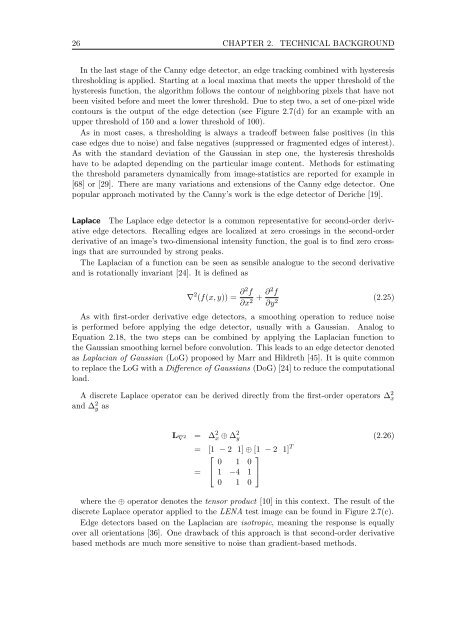Master Thesis - Fachbereich Informatik
Master Thesis - Fachbereich Informatik
Master Thesis - Fachbereich Informatik
You also want an ePaper? Increase the reach of your titles
YUMPU automatically turns print PDFs into web optimized ePapers that Google loves.
26 CHAPTER 2. TECHNICAL BACKGROUND<br />
In the last stage of the Canny edge detector, an edge tracking combined with hysteresis<br />
thresholding is applied. Starting at a local maxima that meets the upper threshold of the<br />
hysteresis function, the algorithm follows the contour of neighboring pixels that have not<br />
been visited before and meet the lower threshold. Due to step two, a set of one-pixel wide<br />
contours is the output of the edge detection (see Figure 2.7(d) for an example with an<br />
upper threshold of 150 and a lower threshold of 100).<br />
As in most cases, a thresholding is always a tradeoff between false positives (in this<br />
case edges due to noise) and false negatives (suppressed or fragmented edges of interest).<br />
As with the standard deviation of the Gaussian in step one, the hysteresis thresholds<br />
have to be adapted depending on the particular image content. Methods for estimating<br />
the threshold parameters dynamically from image-statistics are reported for example in<br />
[68] or [29]. There are many variations and extensions of the Canny edge detector. One<br />
popular approach motivated by the Canny’s work is the edge detector of Deriche [19].<br />
Laplace The Laplace edge detector is a common representative for second-order derivative<br />
edge detectors. Recalling edges are localized at zero crossings in the second-order<br />
derivative of an image’s two-dimensional intensity function, the goal is to find zero crossings<br />
that are surrounded by strong peaks.<br />
The Laplacian of a function can be seen as sensible analogue to the second derivative<br />
and is rotationally invariant [24]. It is defined as<br />
∇ 2 (f(x, y)) = ∂2 f<br />
∂x 2 + ∂2 f<br />
∂y 2<br />
(2.25)<br />
As with first-order derivative edge detectors, a smoothing operation to reduce noise<br />
is performed before applying the edge detector, usually with a Gaussian. Analog to<br />
Equation 2.18, the two steps can be combined by applying the Laplacian function to<br />
the Gaussian smoothing kernel before convolution. This leads to an edge detector denoted<br />
as Laplacian of Gaussian (LoG) proposed by Marr and Hildreth [45]. It is quite common<br />
to replace the LoG with a Difference of Gaussians (DoG) [24] to reduce the computational<br />
load.<br />
A discrete Laplace operator can be derived directly from the first-order operators ∆ 2 x<br />
and ∆ 2 y as<br />
L∇2 = ∆ 2 x ⊕ ∆ 2 y (2.26)<br />
= [1 − 2 1]⊕ [1 − 2 1] T<br />
⎡<br />
⎤<br />
0 1 0<br />
= ⎣ 1 −4 1 ⎦<br />
0 1 0<br />
where the ⊕ operator denotes the tensor product [10] in this context. The result of the<br />
discrete Laplace operator applied to the LENA test image can be found in Figure 2.7(c).<br />
Edge detectors based on the Laplacian are isotropic, meaning the response is equally<br />
over all orientations [36]. One drawback of this approach is that second-order derivative<br />
based methods are much more sensitive to noise than gradient-based methods.














